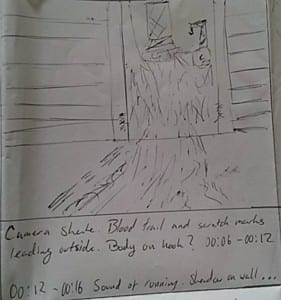Storyboard for my title sequence that ends with the title card.


00:12 – 00:16 Sound of running. Shadow on the wall… blade hit SFX blood and body collapse SFX”



Storyboard for my title sequence that ends with the title card.





Below are similar sorts of designs and style techniques for the title sequence or title card.
1. The Walking Dead (AMC), 2010
The Walking Dead follows a similar style I want to achieve, a lot of close-ups or establishing shots that set the scene for the rest of the programme. Similar to the walking dead I want to show loneliness and desolation. However, I feel as if I should focus more on the horror theme within my own project.
2. American Horror Story (FX, 2011)
American Horror Story uses entirely video footage with no introduction to any characters. Another thing I liked is there was no defining soundtrack. Whereas The Walking Dead times its cuts with its soundtrack. AHS feels like the soundtrack is tied to the footage. A lot of fast cuts creates a lot of tension something that maybe good for my own work. This intro makes me want to attempt to trial video footage as if it’s from a person’s eyes for my own project.
3. The Conjuring (2013)
The Conjuring uses entirely images and news clippings as if they were placed on a light box. What I like about this is its lore telling. Although we are only given images, they are extremely clear and feel like they’re worth taking in to understand the story world we are being shown. The news clippings in particular could be used to hint within my show that the survivors are missing and haven’t been found.
http://www.artofthetitle.com/title/the-conjuring/
For my final proposal. I want to present my idea through a Kickstarter, IndieGoGo or Patreon.
Despite all accomplishing the ability to crowdfund my project, all 3 would require different approaches and decisions to acquire said funding.
Kickstarter
Kickstarter only allows creative projects to be funded. You’re not able to start up a business or general funding. Kickstarter also works in an “All or Nothing” format so a minimum budget for project would be needed.
This would mean that my project would be best presented as a pilot episode. With this I can budget upon a single episode for viewers to enjoy, and with enough publicity use the pilot episode as means to create further funding through either coorperations or through further crowdfunding options.
IndieGoGo
IndieGoGo allows you to create project on anything. They also allow partial funding which means even if the project doesn’t make it’s goal the money raised can still be collected and used.
Using IndieGoGo would allow me to set up funding for the entrie series and use whatever funding made to make as many episodes as possible and push for further funding.